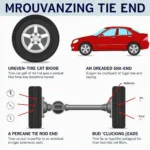Everyone knows the feeling: you start your car and a small yellow light with a bulb symbol illuminates on the dashboard. The “Check Engine Light,” also known as the malfunction indicator lamp (MIL), is a familiar sight for many drivers – often not a welcome one. But what does it actually mean when the check engine light comes on, and what should you do?
The Check Engine Light: A Small Lamp with Big Meaning
The check engine light is part of your car’s On-Board Diagnostics (OBD) system. It indicates that there is a problem with the engine management or emission control system. Unlike warning lights that indicate acute dangers, the check engine light is not a reason to panic, but you shouldn’t ignore it either.
Imagine you’re driving on the highway and the check engine light comes on. In this case, it’s advisable to remain calm. “Often the fault lies with a defective oxygen sensor or a problem with the ignition system,” explains Michael Wagner, a certified mechanic from Berlin.
Causes of a Lit Check Engine Light
The causes for a lit check engine light can be varied, ranging from harmless problems to more serious engine damage:
- Faulty spark plugs or ignition coils: A classic among the causes. Defective spark plugs can lead to misfires and cause the light to illuminate.
- Problems with the mass air flow sensor: The mass air flow sensor measures the intake air volume and plays an important role in the air-fuel mixture.
- Defective oxygen sensor: The oxygen sensor measures the oxygen content in the exhaust gas and influences the emission control.
- Worn catalytic converter: The catalytic converter cleans the exhaust gases and can activate the light when worn.
- Leaks in the intake system: Leaks in the intake system can lead to incorrect readings and trigger the light.
What to Do When the Check Engine Light Comes On?
- Stay calm: As mentioned earlier, the check engine light is not a reason to panic.
- Consult the owner’s manual: Your vehicle’s owner’s manual contains valuable information about the meaning of the warning lights.
- Read out the fault memory: To determine the exact cause of the problem, your vehicle’s fault memory should be read out. This can be done in a workshop or with your own diagnostic device.
- Fix the problem: Depending on the cause of the problem, the corresponding parts must be repaired or replaced.
Preventive Measures
There are some measures you can take to reduce the risk of a lit check engine light:
- Regular maintenance: Regular maintenance of your vehicle, including spark plug replacement and checking the emission values, can prevent many problems in advance.
- Use high-quality fuel: Inferior fuel can lead to deposits in the engine and exhaust system.
- Adjust driving style: A gentle driving style with anticipatory driving protects the engine and the exhaust system.
Ignoring the Check Engine Light – Not a Good Idea!
Even if the check engine light often indicates minor problems, you should not ignore it.
“A permanently lit check engine light can be an indication of a more serious problem that, if left untreated, can lead to costly consequential damage,” warns Dr. Ing. Stefan Berger in his book “Modern Vehicle Diagnostics”.
Frequently Asked Questions about the Check Engine Light
- Can I continue driving with the check engine light on? Basically yes, but it is advisable to have the cause checked as soon as possible.
- What does the repair cost? The repair costs depend on the cause of the problem and can vary greatly.
- Can I read out the fault memory myself? Yes, with a corresponding diagnostic device you can read out the fault memory yourself.
Conclusion
The check engine light is an important part of vehicle diagnostics and should not be ignored. Through regular maintenance and timely action, you can avoid major damage and ensure a safe and reliable ride.
Are you having problems with the check engine light or other warning lights in your vehicle? Our experts at AutoRepairAid are at your side with advice and assistance. Contact us today!
Are you interested in more helpful tips about cars? Read also our articles:

